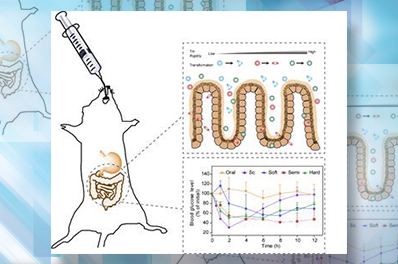Liposomes are consisted of lipid bilayer structure and are ubiquitous in creatures including endosomes, lysosomes, exosomes and synaptic vesicles. They have been extensively applied in drug delivery and dozens of lipid-based products have been marketed.
However, due to the presence of complex biological barriers that severely limit the bioavailability of liposomes, more efforts are demanded and in urgent need to improve their efficiency of drug delivery.
In a study published online in Proceedings of the National Academy of Sciences of the United States of America, research groups led by Prof. GAN Yong from the Shanghai Institute of Materia Medica (SIMM) of Chinese Academy of Sciences and Prof. SHI Xinhua from the National Center for Nanoscience and Technology revealed the relationship between phase transition temperature (Tm) of liposomes and their rigidity that consequently affects their in vivo bio-behaviors.
Previously, they have found that rod-shaped nanoparticles can diffuse faster than spherical ones in mucosal tissues. They subsequently discovered that semi-elastic nanoparticles can rapidly penetrate the biological hydrogels of mucus and tumor matrix via deforming into rod-like shape.
In this work, based on the fact that different kinds of lipids will undergo solid-gel-liquid phase transition process under their respective Tm, they came to the idea of controlling the rigidity of liposomes via altering Tm to improve their diffusivity in biological gels.
Through adjusting the kinds and ratios of lipids, they successfully obtained liposomes with different Tm and rigidity. The diffusion assay suggested that when the temperature approached relevant Tm, each kind of liposomes could reach the highest diffusivity in biological gels.
By means of supra-resolution microscopy and molecular dynamic simulations, they further elucidated that deformation of liposomes and the contact area with adhesive mucin would change to the extent explained by their respective Tm.
As the environmental temperature approaches Tm, it can provide an adequate rigidity for the liposomes that allows them to deform into ellipsoid, an advantageous shape for rapid diffusing in the biological gels.
On a sharp contrary, liposomes with low Tm generating excessive deformation will be severely trapped in the mucin, while those with high Tm cannot effectively deform to reach the considerable diffusivity.
Pharmacokinetics study proved that through rational design of liposomes with appropriate Tm, the oral bioavailability of insulin could be enhanced to 13.7%.
These findings may guide the development of liposome-based drug delivery systems with improved therapeutic efficacy.
This work was supported by the National Natural Science Foundation of China, the Strategic Priority Research Program of Chinese Academy of Sciences, National Center for Protein Science Shanghai and Instrumental Analysis Center of Shanghai Jiao Tong University.
Original article link: https://www.pnas.org/content/early/2019/03/04/1818924116

Schematic illustration of T?m- and rigidity-mediated rapid transport of liposomes across multiple barriers of intestinal mucosa, achieving improved oral bioavailability of insulin. (Image by YANG Yiwei)
Contact:
Prof. GAN Yong
Email: ygan@simm.ac.cn
(Credit: YANG Yiwei; Editor: PAN Peihua)